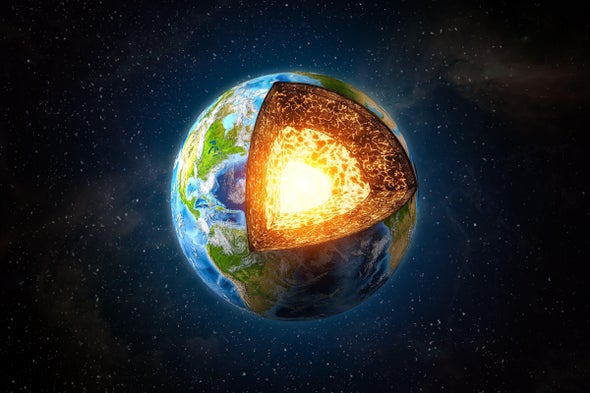Earthscience in Rotation
"It's only contentious because we can't figure it out.""It's probably benign, but we don't want to have things we don't understand deep in the Earth."John Vidale, geophysicist, University of Southern California"The inner core is the deepest layer of Earth, and its relative rotation is one of the most intriguing and challenging problems in deep-earth science.""We are hypothesizing that this [slowed rotation] will continue in the coming years and decades, and we should be able to see that in [our] relatively short human time frame.""The exciting news, is that we don’t have to wait too long.""We believe the inner core rotates, relative to the Earth's surface, back and forth, like a swing,""One cycle of the swing is about seven decades.""We hope our study can motivate some researchers to build and test models which treat the whole Earth as an integrated dynamic system."Xiaodong Song, geoscientist, Peking University"Most of us assumed that the inner core rotated at a steady rate that was slightly different from the Earth.""The evidence accumulates, and this paper shows that the evidence for [faster] rotation is strong before about 2009, and basically dies off in subsequent years."Paul Richards, seismologist, Lamont Doherty Earth Observatory, Columbia University
 |
| Earth’s core structure. Elements of this image were furnished by NASA. Credit: Maksym Yemelyanov/Alamy Stock Photo |
Science never sleeps. The universe is steadily unfolding. And research probes endlessly trying to understand the natural world within ourselves and surrounding us. And what if the very foundation of the natural world closest to us, that we consider our home in the great vastness of the universe is performing mysteriously enigmatic actions that will some day relate to the very stability of what we take for granted; time and the seasons, day and night, ultimately affecting our spin around our life-sustaining sun?
Scientists discovered credible evidence in the mid-1990s that the inner core of our planet, a superheated sphere of iron whose size is similar to that of our moon, was spinning at a pace quicker than the outer core of Earth. A study published recently in Nature Geoscience suggests that the core's rotation has decelerated and was whirling in syncronization with the Earth's surface; a reversed -- lagging behind the surface of the planet.
Years of research and deep discussions among scientists relating to the core and how it influences some fundamental aspects of the planet, including the length of a day and fluctuations in Earth's magnetic field has given way to disagreements among scientific researchers. That solid iron core, sizzling with heat, almost five thousand kilometres below the surface, floats within a liquid outer core.
The liquid in the outer core moves in reaction to the energy released by the inner core, geologists believe. The movement generates electrical currents, in turn creating a magnetic field surrounding the planet that protects organisms on the surface from cosmic radiation damage. This detected inner core slowdown occurred in the later 1960s and early 1970s, leading study authors at Peking University to feel a 70-year cycle of the core's spin results.
The scientific debate over what the mysterious metal sphere at Earth's centre reflects, in reaction to the study stokes the scientific debate. Dr. Song's 1995 work was the first to provide evidence that the Earth's core did not match the mantle's movement. Beneath the mantle and the crust, the core cannot be directly visualized but scientists make use of seismic waves resulting from earthquakes to infer how the Earth's inner core is impacted; as seismic waves travel at varying speeds depending on density and temperature of the rock.
Seismic waves travelling from the sites of earthquakes to sensors on the opposite side of the planet were examined in the study as they passed through the core. Comparison of the waves from similar earthquakes in the same area over the years enabled the scientists to search for and analyze lags of time and perturbations in the waves, giving them indirect insight about the core.
Minute alterations in the length of a day link to the behaviour of the core; the particular details, a matter of spirited debate. But the length of a day has been seen to elongate by milliseconds over centuries relating to other forces, including the moon's magnetic draw on Earth. Ultraprecise atomic clocks measure mysteirous fluctuations. Dr. Song and his research colleagues argue that these variations may explain the core's rotational changes.
When predicable fluctuations in the length of a day resulting from the moon's tidal forces are removed changes are detected appearing to track with the 70-year oscillation in the inner core's rotation. The core's behaviour remains a contested question but there is agreement between geoscientists that as additional data accrues, many of the initial theories of the core's behaviour have become more complicated.
"Ultimately I don't think that things being complicated is a problem in geoscience. We know the surface of our planet is complex ... so it is reasonable to assume the deep interior is also complicated!""To definitely say how the inner core is rotating relative to the outer layers of the planet, we will need to keep collecting as much data as we can."Elizabeth Day, geophysicist, Imperial College London
:focal(3942x2252:3943x2253)/https://tf-cmsv2-smithsonianmag-media.s3.amazonaws.com/filer_public/91/82/918246b8-4e70-41c4-98ec-80319123fc77/gettyimages-1148113995.jpg) |
| An artist's rendition of a cross-section of Earth. The innermost layer, the inner core, is a 1,500-mile-wide ball of iron. CHRISTOPH BURGSTEDT / SCIENCE PHOTO LIBRARY via Getty Images |
Labels: Earth's Inner Core, Geophysicists, Research, Synchronized Movement, Variations in Core Spin

0 Comments:
Post a Comment
<< Home